
How cocreation is helping accelerate product and service innovation In an Industry 4.0 environment, many companies are augmenting their approaches to the development of new offerings
10 minute read
20 April 2020
Rapid innovation cycles are critical to winning in the Industry 4.0 era. This article, the 10th in a series on digital industrial transformation, explores how cocreation can help companies accelerate and de-risk innovation.
Introduction
Traditionally, R&D drives companies’ product innovation and technological advancements. But changing customer expectations and the ubiquity of startup funding, culture, and processes—promoting rapid, agile, and use case–focused innovation—are pressuring leaders to shift their approach to the development of new offerings. This is now truer for B2B companies than ever before, as offering simplicity and strong customer experiences in consumer products have permeated B2B buying processes, customer support, and product updates.
Learn more
Explore the Digital industrial transformation collection
Learn more about Deloitte's services
Go straight to smart. Download the Deloitte Insights app
The impact has begun to reverberate not only across the technology and industrial sectors but across the economy, broadly. For example, a major European bank, known for its hierarchical and policy-driven offer development, restructured its product innovation-related functions (including IT development, product management, and marketing) into small agile “squads,” resulting in faster time to market, greater customer satisfaction, and higher employee engagement.1
Many technology buyers are increasingly expecting quicker and easier integration of new products or solutions with their enterprise systems and applications in order to realize a faster return on their investments. This is especially important as technology budgets often extend outside IT managers to line managers, including operational technology groups. More and more, these buyers expect value through integrated solutions.
But developing and delivering these integrated solutions is often challenging for a single company to address independently, cost-efficiently, and effectively. (See figure 1 for examples of challenges organizations typically face when trying to innovate.) While organizations should continue to invest in robust internal R&D capabilities, today’s changing business environment indicates that companies expand their sources of innovation.

As such, companies have begun to look beyond their four walls to break free of organizational constraints and stay ahead of the curve. In this article, we discuss how collaborative innovation compares to other product development and innovation approaches, the types of innovation partners that might be involved, leading practices, and some success stories from across the marketplace.
“Consider this article the playbook—or a primer—that complements this series’ seventh installment, which addresses how to extract greater efficiency from internal product development.”2
Cocreation: Innovating beyond traditional boundaries
In today’s market, ever fewer organizations can rely exclusively on an internal R&D process to generate innovation. A model of cooperative innovation—an ecosystem—is increasingly critical to drive value for all parties involved. We see this as cocreation—strategic partners actively collaborating to create and deliver customer-centric products and services (offers) that capture greater value, more rapidly and at lower risk than traditional product-development approaches. Figure 2 discusses the benefits of cocreation in greater detail.
A variety of companies are engaging in cocreation—a recent report found that most European organizations have already launched at least one cocreation pilot formally or rolled out cocreation, with 57 percent noting that it transformed their company’s approach to innovation.3
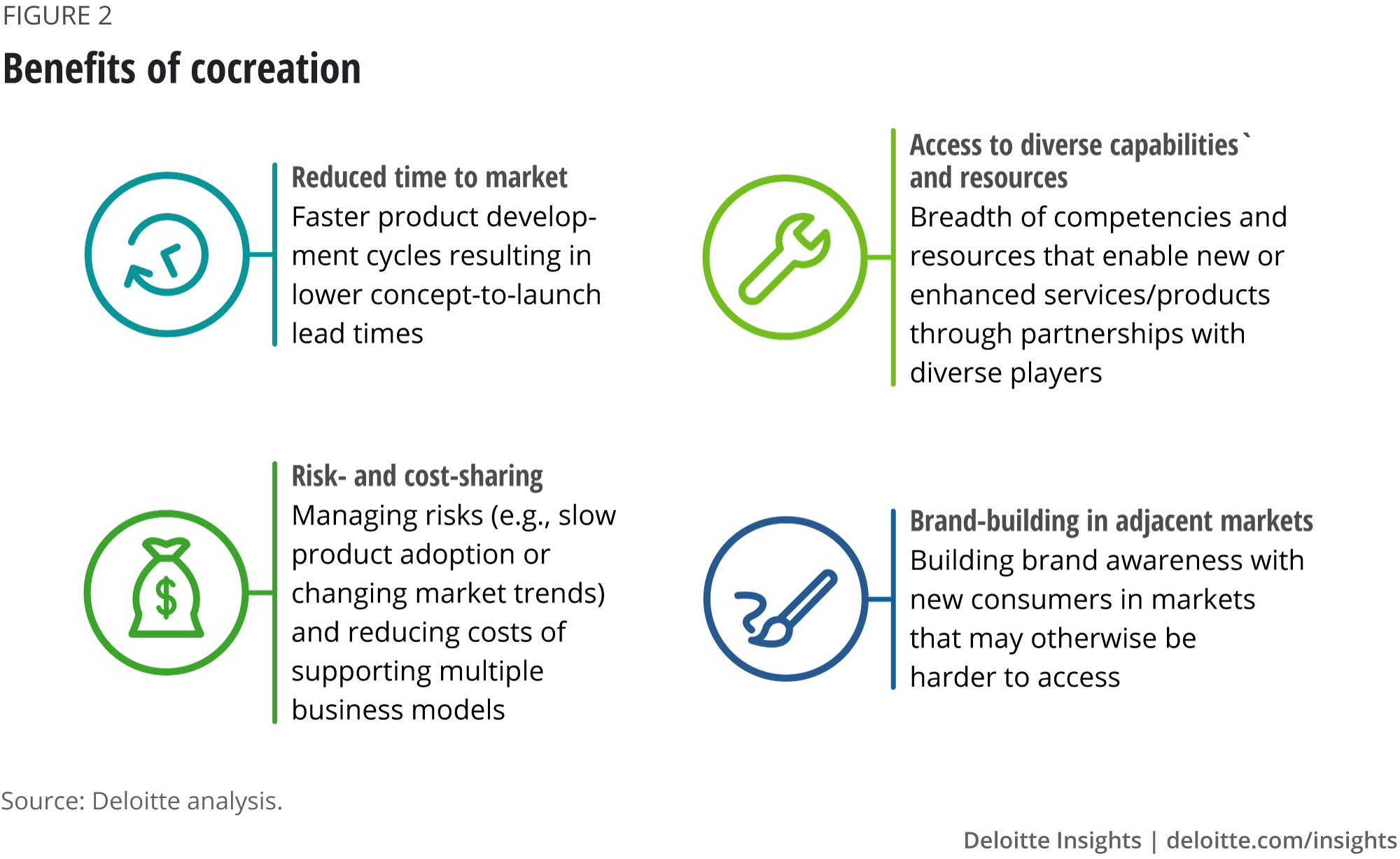
Case study: IBM and CISCO
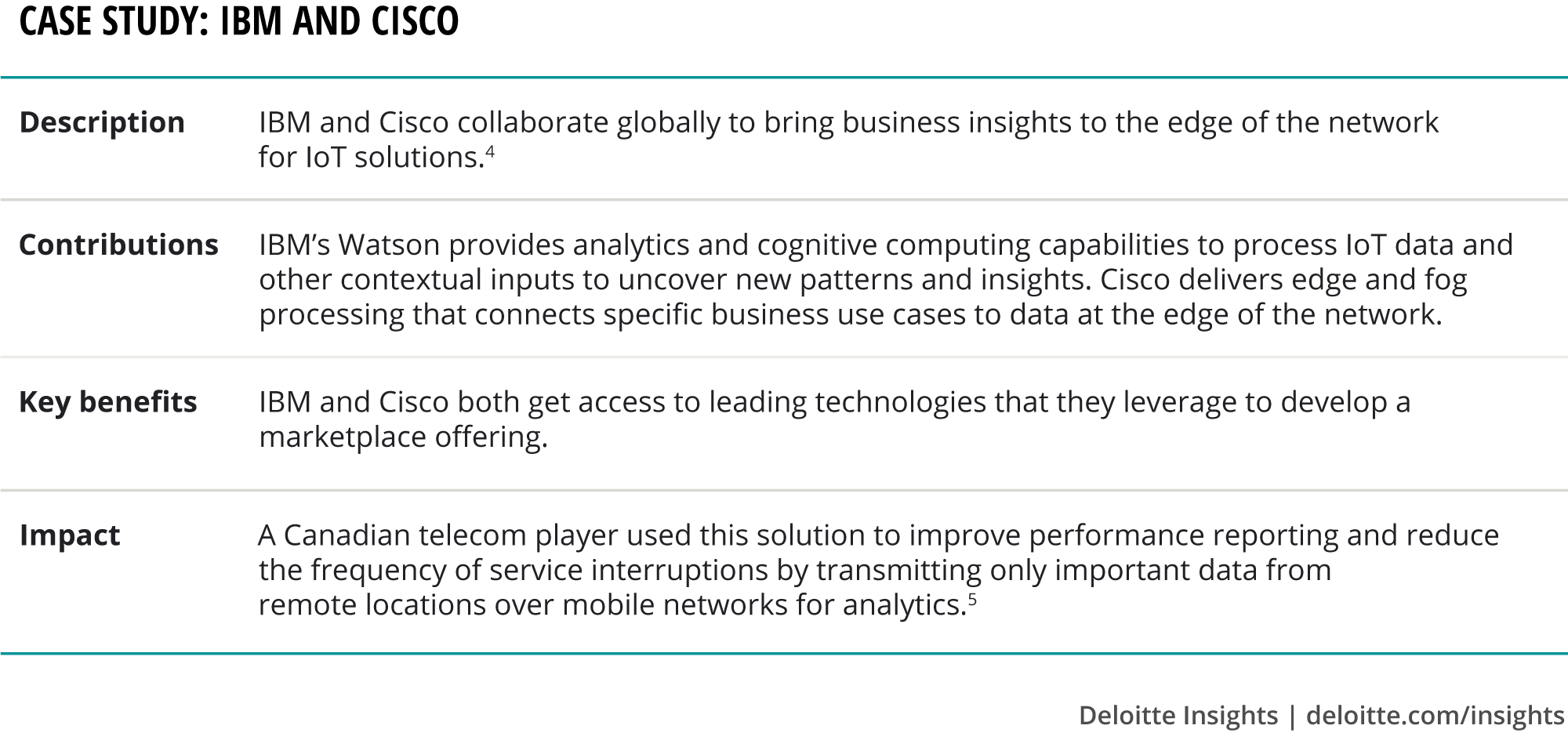
Cocreation vs. other innovation pathways
As cycle times of technological innovations shrink,6 companies have begun to explore new ways to innovate, including strategic partnerships, research labs, and joint innovation centers. Today, companies often have several levers they can pull to support product development. (See figure 3 for a comparison across common pathways to innovation.) Among these, cocreation provides a unique blend of control, cost, and time to impact.
“As cycle times of technological innovations shrink, companies have begun to explore new ways to innovate, including strategic partnerships, research labs, and joint innovation centers.”
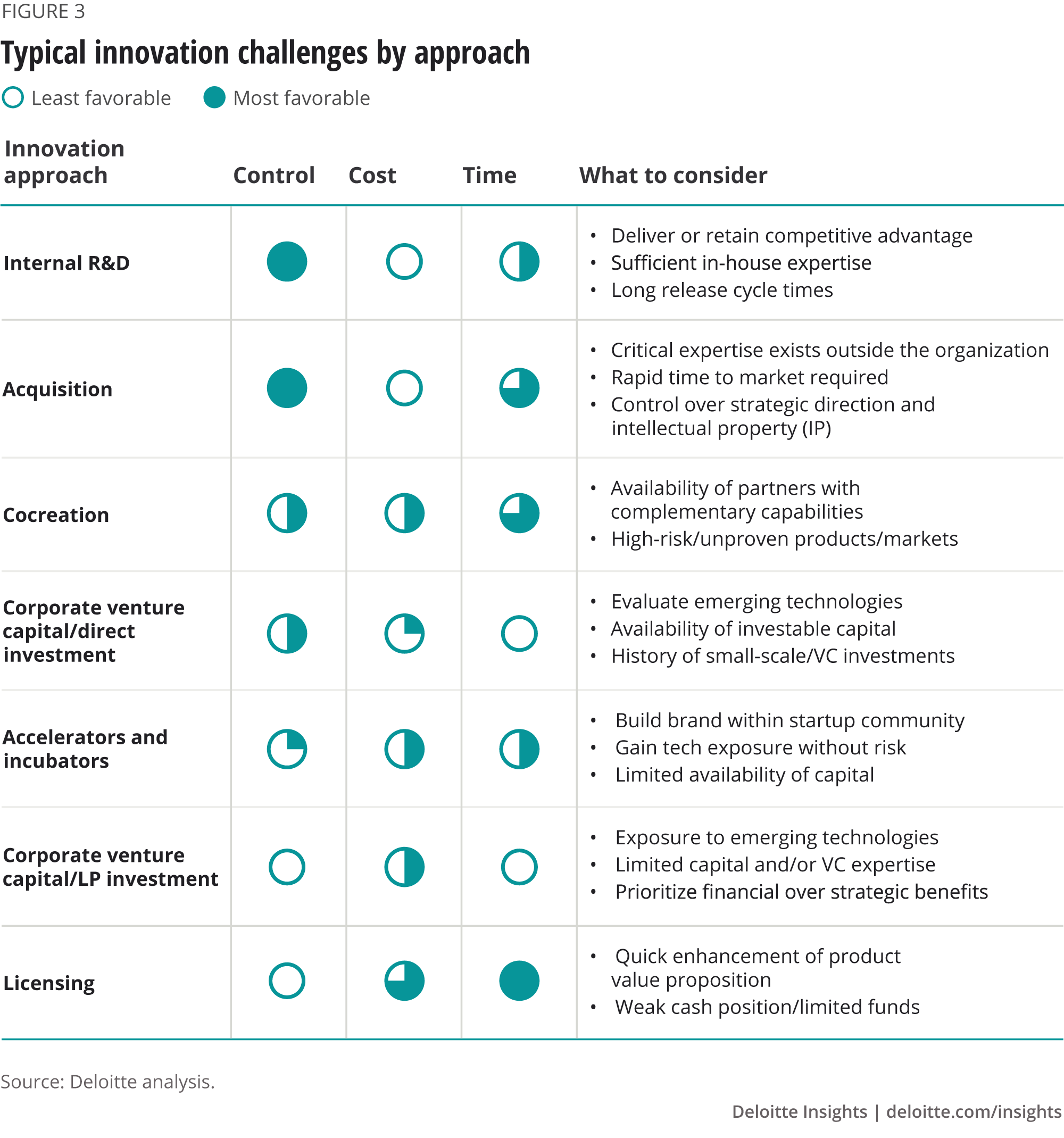
With whom to cocreate?
Organizations that cocreate effectively can engage a broad set of stakeholders to support their innovation needs, including customers, suppliers, competitors, academic institutions, nonprofits, and government agencies. Figure 4 highlights specific marketplace partnerships and the value they have delivered for participants.7
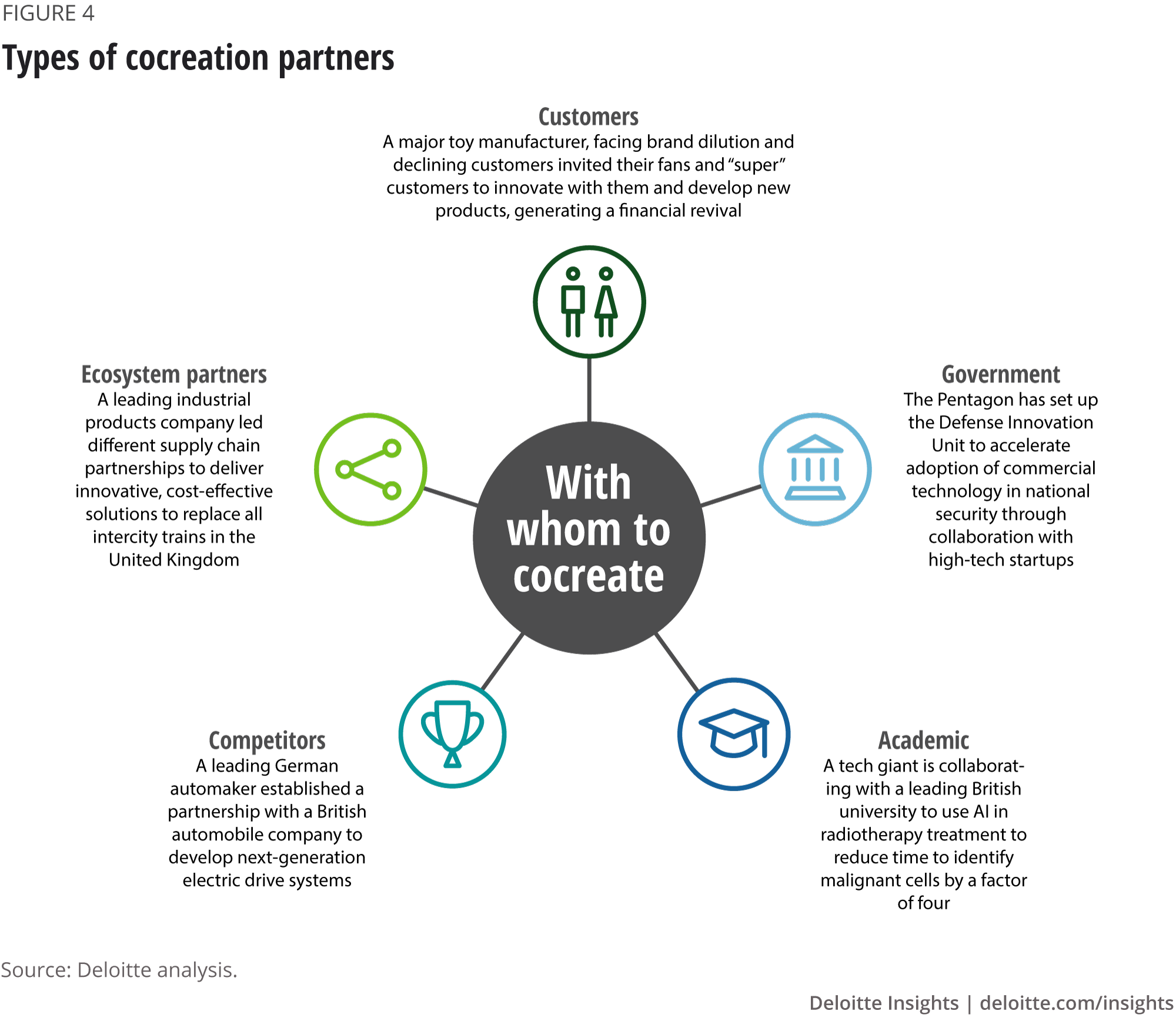
Given the variety of partners with which an organization can cocreate, it is important to select the right type of partner (and the partner itself) by determining internal capability gaps, aligning on partnership goals, and defining a mutual value proposition. As with all partnerships, it is critical that both organizations bring value to the table, so leaders should ask themselves: “What do we have that partners want—or can benefit from?” Most companies assume that their IP makes them valuable to prospective partners; this may be true, but equally important are a healthy risk appetite, a track record of acting collaboratively and with agility, and access to capital, talent, and markets. Finally, cocreators should align on their approach to privacy and data security; these areas are becoming increasingly critical as competitive differentiators given consumer and regulatory scrutiny, so alignment on how data is collected, stored, and monetized is paramount.
“My favorite form of cocreation is when you find a collaborator in someone that you least expected, maybe even a former competitor that actually complements me more than we compete. The question then remains: How do we make this work going forward?”—Robert Schmid, chief futurist, Deloitte Consulting LLP
Case study: Apple and Mastercard
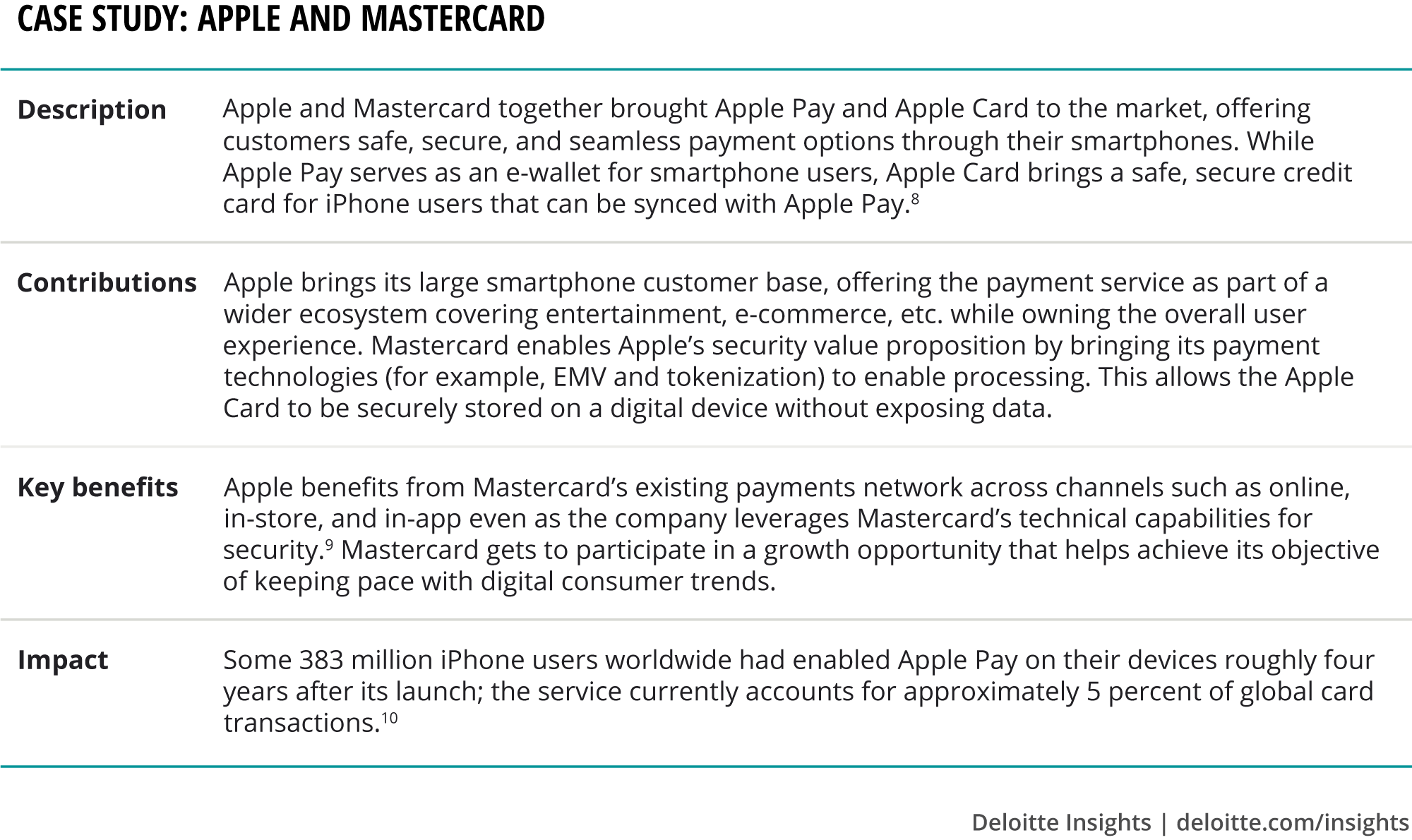
How to cocreate?
While the nature of the solution and choice of partners are critical, we often find the operating and engagement model to be the biggest roadblock in achieving cocreation goals. Operationalizing cocreation requires taking three critical steps. The approach is not dissimilar from developing products internally, discussed in our article on digital product management.11
Why: Strategic objectives
The first step is to align on objectives and priorities of the cocreation initiative. Specifically, leaders should:
- Determine the scope—product, market, customer, investment profile, duration
- Define success criteria—revenue, market share, product launches, recognition
- Identify cocreation timelines
- Align on investments and outcomes that will be shared—equally, by market, by time
For example, TM Forum’s Catalyst platform connects communication service providers with other firms to jointly develop proof of concepts to address common challenges in the telecom ecosystem across emerging areas, such as 5G, AI, and the IoT.12
Who: Capabilities and roles
Organizations engaging in cocreation usually do so because of the complementary capabilities that they bring to the table (figure 5 showcases the key capabilities). Therefore, companies should determine:
- Capabilities required to deliver on the strategic objectives—product, go-to-market, support, services
- How each capability will be delivered—remotely, by a third party, together, as a service
- The role each partner would play in delivering the capabilities—resources, investment, technology, suppliers and distributors
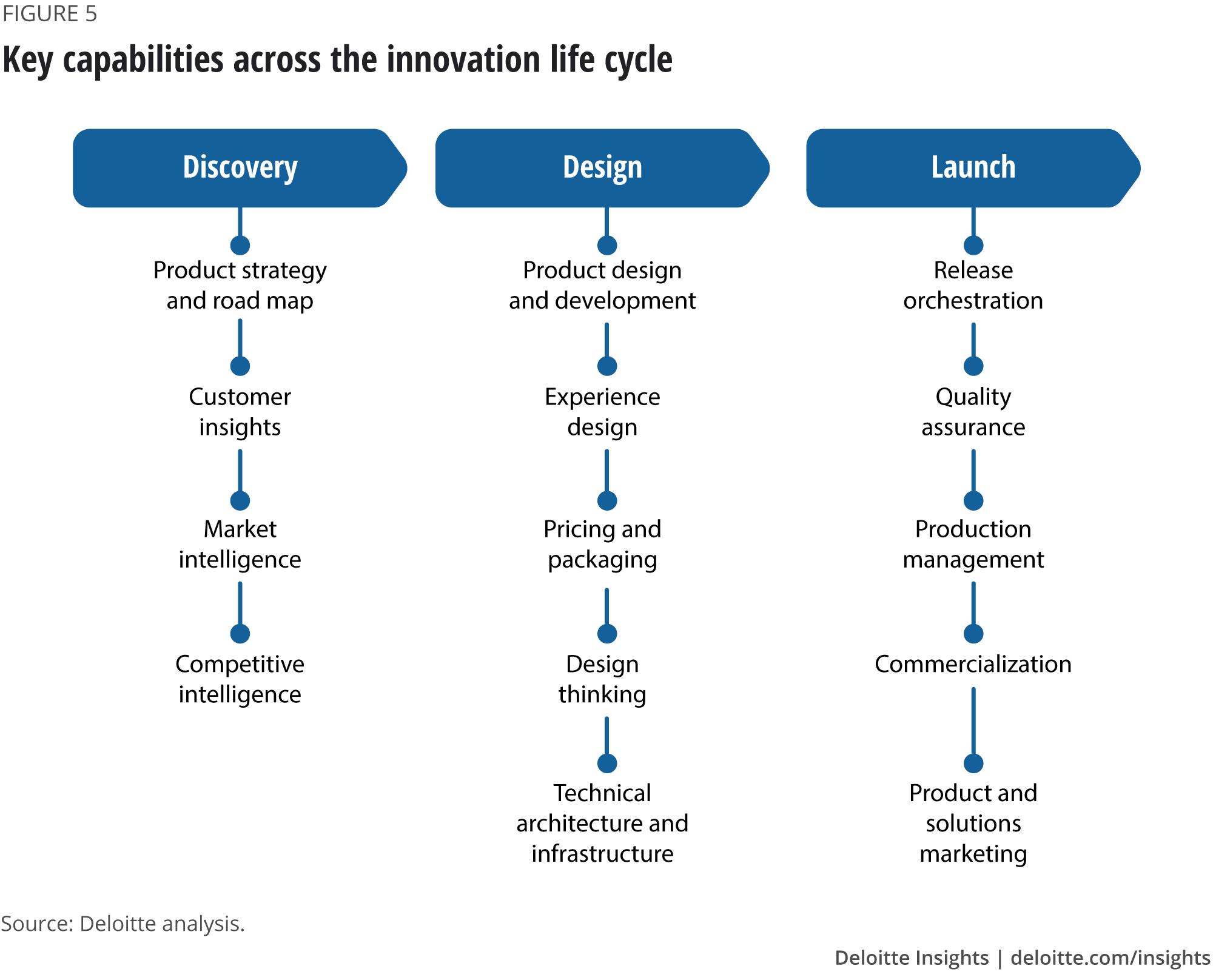
Like the product capabilities listed above, companies typically go beyond product development to align roles across marketing, sales, servicing, and support capabilities. Indeed, examples of complementary capabilities are widespread across technology firms and automobile original equipment manufacturers (OEMs), where the former provides semiconductor and/or software development capability required for cutting-edge applications such as self-driving cars, while the latter offers manufacturing expertise to build complex hardware at scale with high reliability and durability.
How: Operating model
Another critical step is to determine the operating model for cocreating teams. While there are multiple options available to structure teams, the optimal choice will depend on capabilities selected, their maturity, partner roles, and the nature of the working relationship (figure 6).
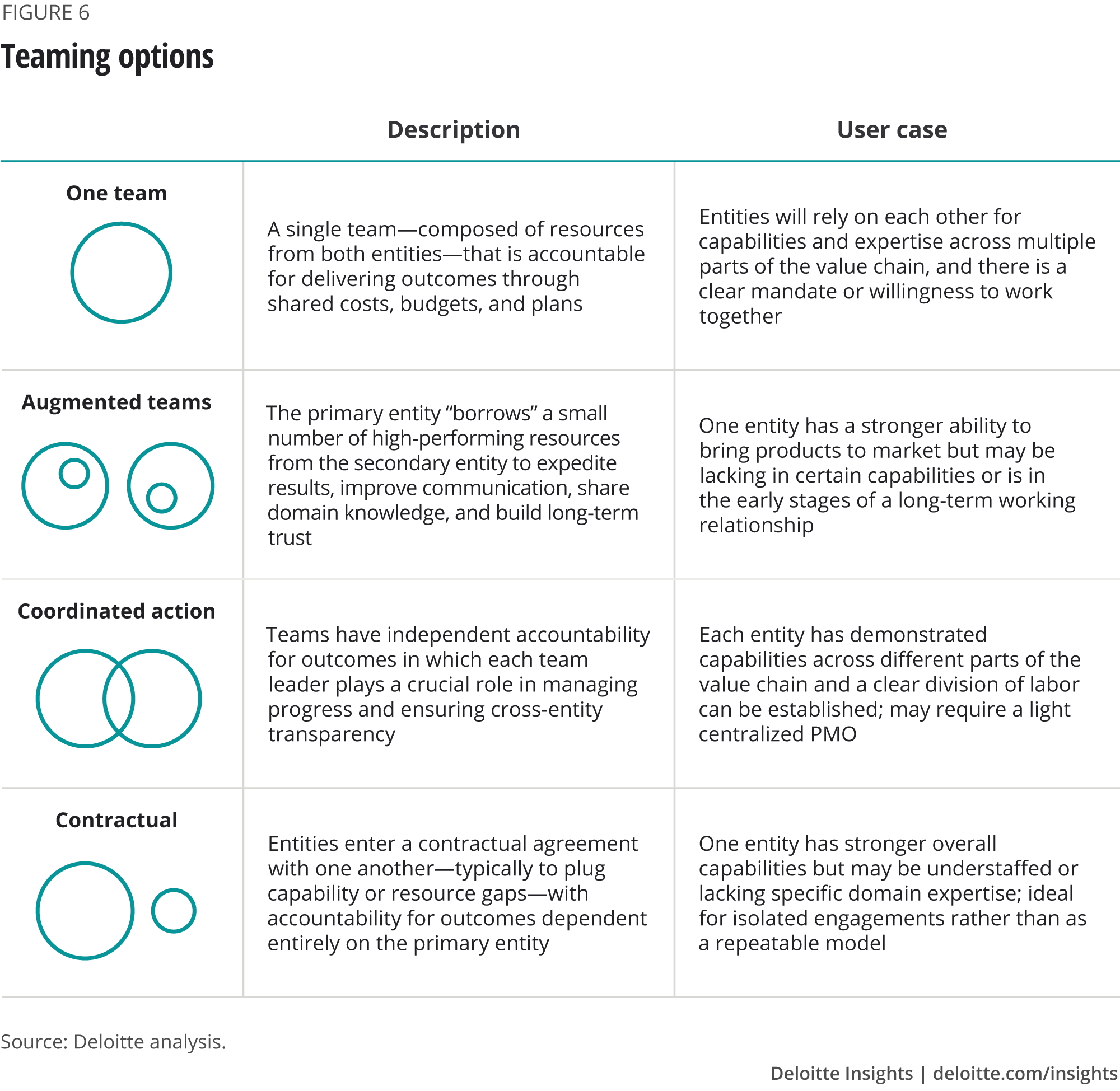
Not every partnership is successful, of course. Some cocreators discover that they have differing visions well into their partnership; other partnerships fail because initial product launches fall short of expectations. Some partnerships lose their spark gradually as the initial excitement fades. We see value, then, in driving accountability—at the executive level—for managing a network of cocreation partnerships. Also, extending the principles of agile product development to partnership building—employing a “learn fast” method—makes for better allocation of scarce resources to the most lucrative partnerships.
If you do only five things
While cocreation can be a force multiplier for innovating in an Industry 4.0 environment, the probability of success depends on the right environment. Our experiences as both advisers and cocreators have unearthed five elements that are accretive to cocreation pursuits:
Structure of the entity and allocation of IP ownership. While informal collaboration and even sharing of resources might work, it is often beneficial to set up an equity alliance or joint venture. This is especially useful in situations where partners are new to working with one another, or in multipartner cocreation. Additionally, it helps to clarify how ownership rights for new IP from the partnership will be allocated. However, the complexity and management overhead typically follow a stated, long-term commitment to collaboration. We will explore this in greater depth in another article in this series.
Go-to-market and rights to monetize. It is critical to clarify how each partner will reap financial benefits from cocreation, including the appropriate monetization model (revenue share, license fees, commissions, royalties, etc.) for IP and data generated from launching the innovation, as well as ownership of go-to-market efforts. When multiple participants are involved in taking innovations to market, collaborators should proactively reduce the probability of conflict by identifying the customer segments that each partner will target—for example, by size, geography, or industry.
Governance. Maintaining momentum throughout the cocreation requires clear stage gates or key milestones to review progress to ensure teams are not overburdened with frequent or unnecessary reporting activities. As such, it is crucial that companies define early what happens at these milestones—for example, expectations of progress made, decision-makers, scope of decision-making, and processes for escalating unresolved issues. Finally, agreement on conditions, rights, and outcomes related to termination of the partnership can de-risk transitions in unfavorable situations.
Culture and organization. Cocreation involves a shift in thinking from the organization as the sole driver of innovation to collaboration with a network of partners within and outside the industry. This requires change management to embrace partners’ cultural changes along with their unique talent models, processes, and technologies. For example, it might be helpful to change frequency and type of progress reporting in partnering with startups or academic institutions that may be unused to a corporate setup.
Enabling infrastructure. Interorganization collaboration requires enabling technologies, tools, and processes that protect each party’s independent interests. For example, collaboration platforms that enable real-time communication, coordination, and content sharing—such as Slack, Teams, and Jira—can significantly ease teaming across organizations. Additionally, setting up “clean rooms”—digital storage of sensitive business assets—with defined and restricted access across participating organizations can support data sharing without leakage of sensitive information.
“While cocreation can be a force multiplier for innovating in an Industry 4.0 environment, the probability of success depends on the right environment.”
Case study: Intel and SAP
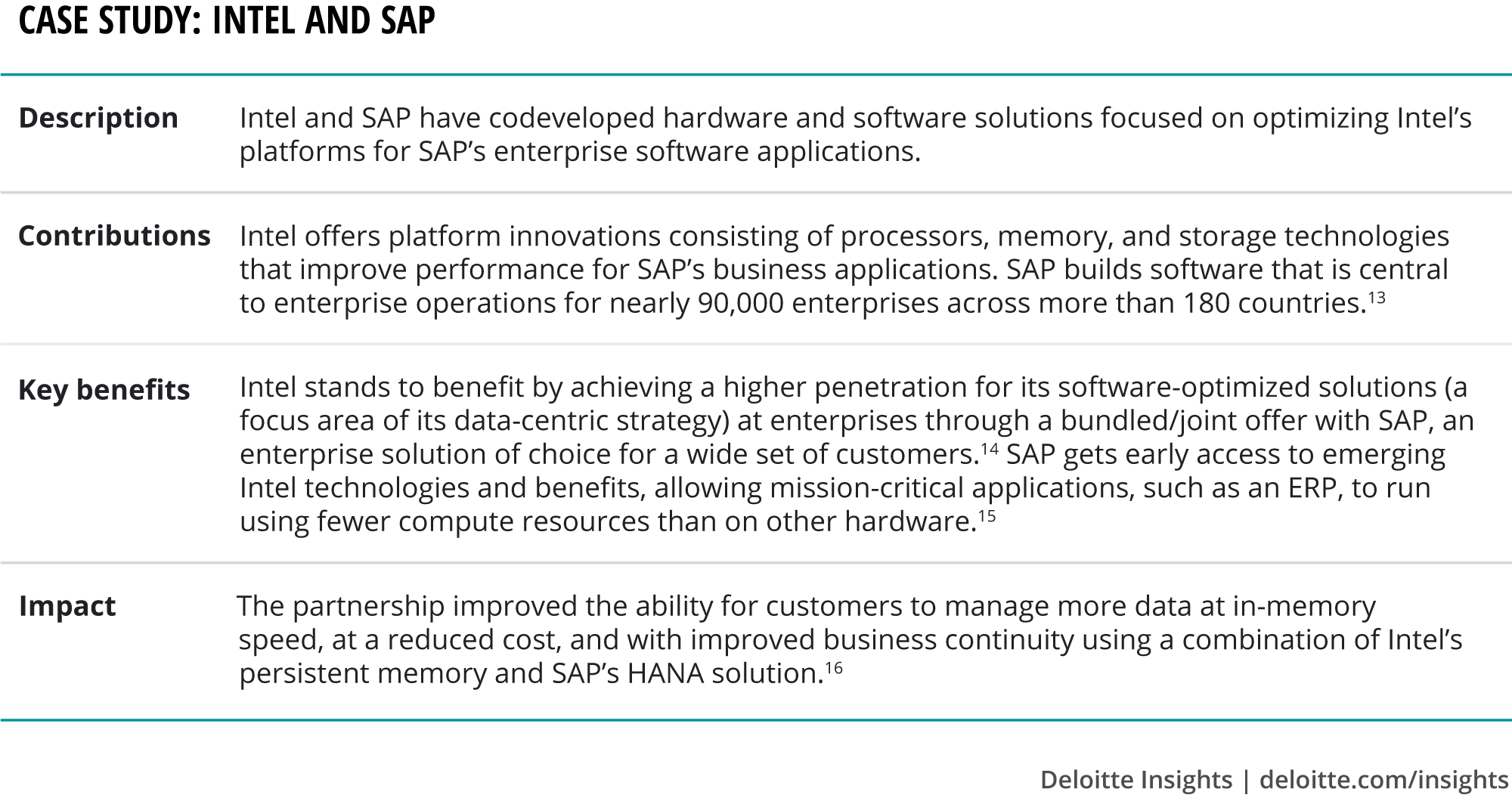
Closing thoughts
Across sectors, pioneering companies have profited by expanding innovation outside their organizational boundaries.17 The most successful innovators are now leveraging an ecosystem strategy to align their product portfolio with technology shifts, market trends, and evolving customer needs. A cocreation strategy and operating model that align with overall corporate strategy and innovation objectives can position organizations for success in the digital economy.
Indeed, cocreators and collaborators come from a variety of places, and enterprises that proactively seek out new partnerships and dynamically evaluate existing ones are likely to reap the greatest benefits. So with whom will you cocreate next—and where will you find your cocreator?
Explore the Digital transformation collection
-
Customer-centric digital transformation Article4 years ago
-
Architecting an operating model Article4 years ago
-
Digital transformation as a path to growth Article4 years ago
-
Staying focused and on track in Industry 4.0 Article4 years ago
-
Digital industrial transformation Article5 years ago
-
Ethical tech Article4 years ago
















